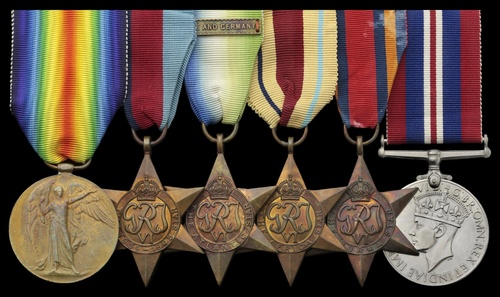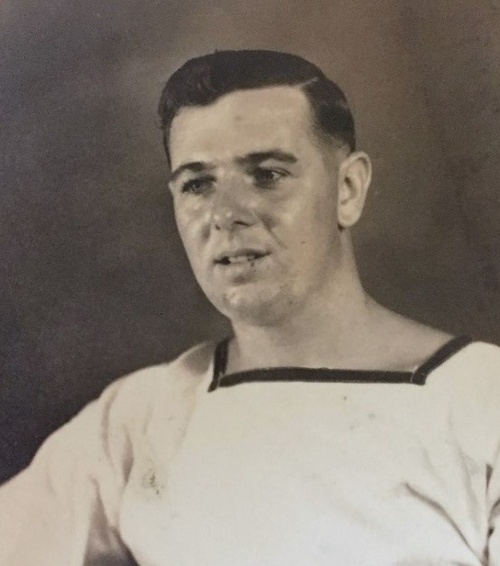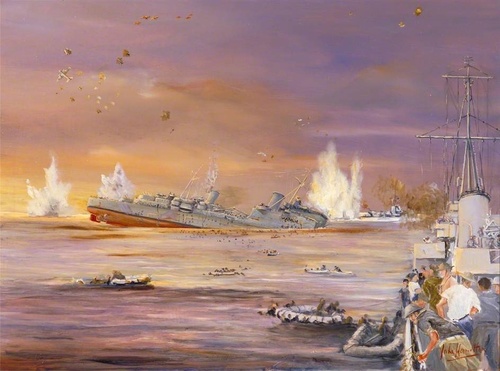Auction: 22003 - Orders, Decorations and Medals
Lot: 392
'My father remained at this task until the ship lost way and there was nothing else he could do. When the order came to abandon ship - shouted from the bridge by Captain William-Powlett - my father was adjacent to 'B' turret. He noticed a 'Roy' (Royal Marine) standing near the guard rail. He said to him, "Come on Roy, you better go," when at almost the same moment, the Marine fell forward over the guard rail into the sea with a cannon shell sticking out of his back.
The ship continued to list and sailors were throwing overboard anything that would float and then jumping into the sea. Others, including my father, moved slowly towards the stern of the ship which was the lowest point of the vessel to jump from. At some point near the stern a single aircraft approached and released two bombs. He watched them fall and even recalls vividly today that they were black with white noses, surrounded by a red ring. The bombs impacted aft of the bridge near the 'Y' turret. When he saw the bombs falling, he sought the shelter, for what it afforded, of a small capstan and hung on tightly.
The bombs exploded with a terrific heat which singed off all of his body hair (so he discovered later). The shock wave was so violent that it tore off the boiler suit he had been wearing and blew him overboard, severely stunned. When he collected his senses, he was on a survivors' net, completely naked. There were two other seamen already on the net and he assumes to this day that it was one or both who had dragged him to safety. The Fiji continued to list even more; there was a lot of noise with men shouting out and aircraft machine-gunning the survivors … '
An extract from the joint account of the loss of the cruiser H.M.S. Fiji off Crete on 22 May 1941, compiled by ex-Leading Seaman Clem Walker and his son; see https://www.world-war.co.uk/fiji_story.php
A documented Second World War campaign group of five awarded to Able Seaman L. W. Rafter, Royal Navy, who survived the loss of the cruiser H.M.S. Fiji off Crete on 22 May 1941
The 22nd proved to be a disastrous day for the Royal Navy, for in addition to Fiji's loss - following no less than 20 air attacks in a period of four hours - her consort Gloucester met a similar fate, as did the destroyer Greyhound: many of the survivors were mercilessly machine-gunned in the water by the Luftwaffe
For his own part, and in mounting darkness, Rafter clung stoically to a life raft for several hours until picked-up by our destroyers: over 230 of his shipmates were less fortunate
1939-45 Star; Atlantic Star; Africa Star; Burma Star; War Medal 1939-45, good very fine (5)
Leslie Wilson Rafter was born at Sankey, Lancashire on 4 April 1920 and entered the Royal Navy as an Ordinary Seaman in July 1940.
Having attended the training establishment H.M.S. Raleigh, he joined the cruiser Fiji in November 1940, and remained likewise employed until her loss to enemy aircraft in the Crete operations of May 1941.
Tragedy off Crete
Fiji met her end in the early evening of the 22nd, whilst operating alongside Rear-Admiral E. L. S. King's Force C.
In common with her consort Gloucester, and the destroyers Kandahar and Kipling, she had gone to the rescue of the crippled Greyhound. But as Anthony Beevor relates in is definitive history - Crete: The Battle and the Resistance - it was an ill-judged mission:
'Such a concentration of virtually stationary ships brought wave after wave of German bombers and fighters whose pilots did not shrink from machine-gunning survivors in lifeboats or the water. King, told of the shortage of ammunition, instructed the two cruisers to withdraw. On their way back, Gloucester was hit by several bombs within view of the Warspite. On fire, with her superstructure twisted into grotesque shapes, Gloucester was doomed. King and Rawlings in Warspite, agreed that the battle-fleet should not be put at risk any longer. Fiji was forced to accept that she must leave Gloucester, which the Luftwaffe did not allow to sink in peace. Her crew were also machine-gunned in the water. Altogether 722 officers and ratings from the ship lost their lives.
Air attacks continued as Force C and Force A1 withdrew to the south-west. Two bombs hit the battleship Valiant, in which Sub-Lieutenant Prince Philip of Greece was serving. Then, two hours later, at 6.45 p.m., a Messerschmitt 110 suddenly appeared out of a cloud and dropped its bomb on Fiji. The damage brought the cruiser to a halt. Thirty minutes later at last light another aircraft appeared, a Junkers 88 flown by Lieutenant Gerhard Brenner on his fourth mission of the day. Brenner, who had taken part in the attack on the Perth south-east of Milos and, after skirting the Warspite, in an unsuccessful attack on the Fiji, had set out alone on her trail once more. He dropped three bombs and the Fiji capsized. Over five hundred of her crew, most of them clinging to life-rafts, spent several hours in the water that night. Eventually, two large shapes appeared, Kandahar and Kingston, and the survivors were hauled aboard on scramble-nets.'
Some prodigious examples of courage and self-sacrifice were performed that fateful day, not least by Fiji's Chaplain. Gordon Holman's The King's Cruisers, takes up the story:
'There were many wounded among them, and the Fiji's Chaplain, the Rev. C. C. Tanner, a former Cambridge Blue and England rugger player, was indefatigable in his efforts to help them. Earlier, he had concentrated on getting wounded men from the sick-bay when it was clear that Fiji's end was near. He was one of the last to leave the ship. So exhausted was he by his efforts that when, at last, he was taken from the water, Tanner collapsed and died. He was posthumously awarded the Albert Medal.'
Subsequent career
Coming ashore to Pembroke in May 1941, Rafter joined the battleship Resolution in October of that year and remained likewise employed until October 1943, mainly as part of the Eastern Fleet in the Indian Ocean.
He served latterly in the Landing Ship (Tank) 198, from May 1944 to May 1945, and he was released 'Class A' in February 1946.
Sold with a quantity of original documentation, including:
(i)
The recipient's parchment Certificate of Service.
(ii)
His Torpedo History Sheets (3), including one issued at R.N. Torpedo School, Chatham in February 1944, together with his Trade Certificate as a Seaman Torpedoman, dated January 1946.
(iii)
His wartime photograph album, the inside cover inscribed, 'Leslie W. Rafter, C/JX. 204267', with some 60 images of ships, ports and personnel.
Subject to 20% VAT on Buyer’s Premium. For more information please view Terms and Conditions for Buyers.
Sold for
£170
Starting price
£160









